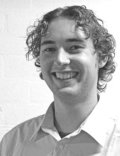 In this thesis the use of acoustic waves, to concentrate small particles from water, is explored. This is a promising approach in novel lab-on-a-chip functionalities.
In this thesis the use of acoustic waves, to concentrate small particles from water, is explored. This is a promising approach in novel lab-on-a-chip functionalities.
‘Two acoustophoretic forces determine particle behaviour here,’ says Jorick van ’t Oever. ‘Acoustic radiation force concentrates particles into nodes and anti-nodes. The other force, steady acoustic streaming, typically causes mixing of the particles via the so-called Stokes drag force.’
The streaming facet becomes dominant for very small particles. ‘However, we discovered another mode, where streaming and the radiation force work together,’ Jorick says. ‘We observed concentration of particles into regions close to the wall. Numerical calculations showed concentration of polystyrene particles down to 100 nm in diameter. Surprisingly this is within the streaming region! The particles slowly spiral towards the concentration maximum.’
These insights proved promising, to concentrate small pathogens from sampled drinking water. ‘In this PhD project we collaborated on this theme with Wetsus Research,’ Jorick says. ‘Personally, I value this collaboration aspect greatly. It is a task in itself, to maximize the application potential of scientific research, while also dealing with the inherent uncertainty one encounters searching for a scientific solution to a problem.’
To cope with this double-minded starting point, Jorick always kept in mind the requirements as set by daily practice. ‘For example, to develop innovative in-line sensors for monitoring and improving drink water quality, price settings are crucial. In this case, silicon or glass fabricated solutions are required because it allows for mass-production. My research activities were always aimed towards this kind of devices.’
An important function in labs-on-a-chip is mixing. Acoustic streaming can be used to purposefully induce local mixing flows. In this PhD project, a centimetre-scale acoustic micromixer was fabricated, using Direct Laser Writing (DLW), consisting of many cuboid micropillars. ‘In fabrication, a trade-off must be made between writing time, accurate structure placement and initial alignment,’ Jorick concludes.
Sensitive to changes
Both the acoustic mixing and concentration function strongly depend on acoustic resonances. The pressure distribution is very sensitive regarding to changes in material properties (such as an increase of particle concentration) and water temperature.
‘Existing resonance characterization methods, rely on measuring the movement of suspended particles, and therefore cannot be used with low particle concentrations,’ Jorick concludes. ‘We developed an optical method, to directly measure the acoustic mode inside a microchannel, using stroboscopic white-light interferometry. In this way we can make the acoustic resonances visible and obtain the spectral line width and Q-factor of individual resonances. The optical characterization method can be used to improve the design of acoustic micro-resonators in microfluidic systems.’
Railroad tracks
The white-light interferometric imaging technique, can also be applied to other problems in various application areas. ‘We used this method to measure micro-cracks in railroad tracks,’ Jorick shares. ‘By using an imaging spectrograph, we sacrifice one imaging dimension, in order to gain significant improvements in measurement speed.’
With his experimental setup, Jorick was able to measure the height line profile of a railroad track containing a 26 µm deep micro-crack, in a single shot of 11.8 milliseconds. ‘By measuring differences in optical path lengths, in combination with other optical parameters, the application potential in other fields will be present as well,’ he says.
ASML
Calibration of optical systems for optical lithography - for the fabrication of next generation semiconductor chips - is the central focus of the job Jorick fulfils now at ASML Veldhoven, after his Defense.
‘During the PhD project, I felt the need to work in a team, with peers sharing one common research goal,’ he explains his choice. ‘More PhD’s share this feeling, as academic research is quite individually based. Also, the best lesson I learnt is the need to always keep your ultimate goal in mind, and the need to make, sometimes radical, choices in order to keep progress alive.’
Transfer of knowledge
At ASML Jorick collaborates with other colleagues on a daily basis, for example with software engineers and customer support. Jorick: ‘We have to carefully transfer our knowledge and progress in research to them, and take into account their needs and pre-conditions.’
‘There is a large didactic aspect to my work. This feature of my job, I learnt during the PhD project, while giving tutorials for the course Dynamics. Students ask simple, fundamental questions about how a dynamic system behaves. In order to help them you do really need to fundamentally understand both the question and the answer. Next to teaching, I learnt a lot in collaborating with student researchers who contributed to the progress of my research in a significant way. I learnt that fruitful collaborations largely increase efficiency and effectivity of research.’
